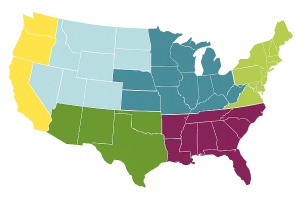Aster – Fall’s Flashiest Starburst
When most blooms begin their final bow, Asters take center stage with a dazzling encore. These star-shaped flowers erupt in dreamy shades of violet, pink, blue, and white—reviving autumn gardens with color and cheer. Hardy and cold-tolerant, Asters thrive with little care, and their late-season blossoms attract bees, butterflies, and other pollinators when they need it most. Naturally deer resistant and perfect for borders, containers, and meadow plantings, Asters deliver low-maintenance magic right when the garden needs it.
Why Plant Asters? Because Fall Deserves Fireworks.
Just when the garden starts whispering goodbye, Asters shout encore! These late-season bloomers light up the landscape from summer’s final act into the crisp days of fall, offering a last hurrah of color when most flowers fade. But they're not just a feast for the eyes—Asters serve up essential nectar for bees, butterflies, and especially Monarchs, fueling their epic fall migration.
Easygoing and eager to please, Asters thrive in full sun and well-drained soil with little fuss. They're naturally deer resistant, bloom for weeks on end, and bring a buffet of benefits to pollinator-friendly gardens. If you're planting with purpose—beauty, biodiversity, and seasonal sizzle—Asters are a must-have in your meadow masterpiece.
Our Favorite Aster Perennials
Asters come in a delightful array of colors and forms, and we’ve handpicked standout varieties that deliver a perfect blend of garden performance and seasonal dazzle. ‘Wood’s Light Blue’ Aster enchants with soft purple-blue blooms and a tidy, mildew-resistant habit, making it a dream for borders, containers, or massed garden drifts. ‘Purple Dome’ Aster is a crowd-pleaser, flaunting rich violet, daisy-like flowers with cheerful yellow centers—lighting up the landscape late into the season while feeding hungry pollinators. For a more refined look at the garden’s edge, ‘Wood’s Blue’ Aster provides dense, fine-textured blooms on a compact plant that’s just right for front-of-border plantings. And if you're looking for a true showstopper, KICKIN® Carmine Red Aster lives up to its lively name, bursting into a profusion of magenta-red flowers on a bushy mound that blooms for weeks with absolutely no cutting back required. Each of these varieties brings its own charm to the garden stage, ensuring the late-season show ends on a high note.
How To Plant Asters: Set the Stage for Fall Color
Planting Asters is a breeze, and the rewards are well worth it. Choose a sunny spot where your plants will bask in at least six hours of direct sunlight each day. Well-drained, loamy soil is best—avoid soggy clay that can lead to root rot, as well as overly dry sites where plants may wilt. Before planting, gently tease apart any tightly wound roots to help them stretch out and settle in. Spacing is also important: depending on the variety, leave one to four feet between plants to give them room to breathe and bloom. Timing matters too. In northern regions, plant any time from spring to early fall so roots can take hold before winter arrives. In the South, spring and fall are the ideal seasons to get your Asters growing.
How To Plant Asters: Set the Stage for Fall Color
Planting Asters is simple—and the payoff is pure autumn magic. Choose a sunny spot with at least six hours of direct sunlight and well-drained, loamy soil. Avoid heavy clay or overly dry areas, which can stress roots. Gently loosen any tangled roots before planting to encourage healthy growth. Depending on the variety, space plants one to four feet apart to allow for air flow and full, bushy blooms. In the North, plant from spring through early fall; in the South, stick to spring and fall for best results.
How To Care for Aster Plants: Low Maintenance, High Reward
Once established, Asters thrive with minimal fuss. Keep young plants watered during dry spells, and mulch in spring to lock in moisture and keep weeds at bay. Taller varieties may need staking midsummer, and a light pinch in early summer can encourage fuller growth—just don’t pinch past July. Divide every few years in spring to keep plants vigorous. After frost, trim back to a few inches above ground. With good spacing and airflow, Asters stay healthy and mostly carefree, rewarding you with vibrant blooms season after season.
Aster Planting Guides
How To Grow Aster
All About Aster
Tips For When Your Perennials & Bulbs Arrive
